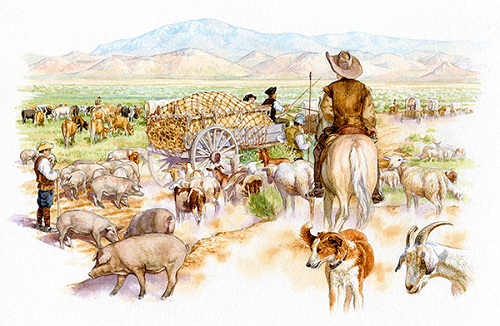Traditionally, the telling of the history of the Mexico, US and Canada moves from east to west, cast in a timeline of the notable people, places and events that shaped the country from the arrival of the Europeans. El Camino Real de Tierra Adentro (Spanish for “The Royal Road of the Interior Land”) is a north-south 1600 mile (2560 kilometer) alternative path to understanding the diverse international history and cultural heritage of Mexico that runs right through town and can be experienced as living history just a city bus ride away.
The Camino Real de Tierra Adentro, also called the Silver Route, stretched from Mexico City to Santa Fe. From 1598 to 1882 nearly three fourths of it resided in central Mexico including part that runs uphill into the Balcones (though that’s hard to tell today particularly since the historical sign identifying the road as such has rusted). The trail greatly improved trade with our neighbors and helped the Spanish conquistadors spread Catholicism throughout the conquered lands
El Camino Real’s story begins with the 1546 discovery of a large silver vein in Zacatecas, Mexico. Twenty-seven years earlier, Hernán Cortés and his Spanish army had invaded Mexico, defeating the mighty Aztec Empire to control the region they called New Spain. The Spaniards’ mission was twofold: to exploit the region’s mineral wealth and to convert the indigenous. The route was actively used to transport silver extracted from the mines of Zacatecas, Guanajuato and San Luis Potosí. But that’s not all that was moved.
For Spanish settlers in SMA, El Camino Real was the bridge to preserving cultural and religious traditions, communicating with loved ones and maintaining a European identity. In addition to religious art, the road delivered such luxury goods as wine, olives, nuts, chocolate, preserves, porcelain, silk and cast iron beds into town, as well as peaches, apples, chiles, wheat and other crops. Livestock, including sheep, horses, goats, pigs and cattle, were, and are, transplanted via the trail.
A caravan on El Camino Real were known as la conducta, loosely translated as a “community in miniature,” .The ten miles a day caravans had their departures celebrated as an important and festive social event. The presence of military escorts that accompanied the caravans along every step of El Camino Real symbolized their commercial and cultural value and the need for protection from the Chichimeca, the indigenous hunter gathers.
The Chichimeca, whose territory El Camino Real encroached locally, would attack the caravans not for the silver, but the food. This continued for decades until the arrival of the Senor of the Conquest cross at the Parroquia providing a Jesus that looked Chichimeca and reflecting the images of everyone that views it.
With the arrival of the railroad, El Camino Real receded back into the earth through disuse and erosion. Often, the road literally fades from the landscape, sight and memory. The railroad made transportation of goods easier to and from SMA, and often made travel quite luxurious and exciting versus exhausting and potentially lethal.
Though the railway overpowered El Camino Real’s primary transportation purpose, the trail’s cultural and commercial influences remain imprinted on our region’s physical landscape, social psyche and living history.
If you take a bus out to the area of St. Matilde you can gambol a stretch of the Camino Real leading to Palo Colorado and take another bus back into town. The route is rough offering great mountain views, occasionally bovine traffic jams and an imminent sense of what it was like to travel the Silver Route way back when.
Speaking of livestock, beware of the Mom Pigs with her piglets. She is very protective being all too aware her children do, in fact, taste like bacon to the loose dogs about.
You’ll pass the well maintained Chapel La Mesita flanked by a lovely Organ cactus garden. It was the last protected stop before entering San Miguel from the north.
Best of all, you can walk part of El Camino Real while here in San Miguel enjoying more modern accessibility and international culture!
Joseph Toone is the Historical Society’s short-story award winning author of the SMA Secrets book series. All books in the series are Amazon bestsellers in Mexican Travel and Holidays. Toone is SMA’s expert and TripAdvisor’s top ranked historical tour guide telling the stories behind what we do in today’s SMA. Visit HistoryAndCultureWalkin










